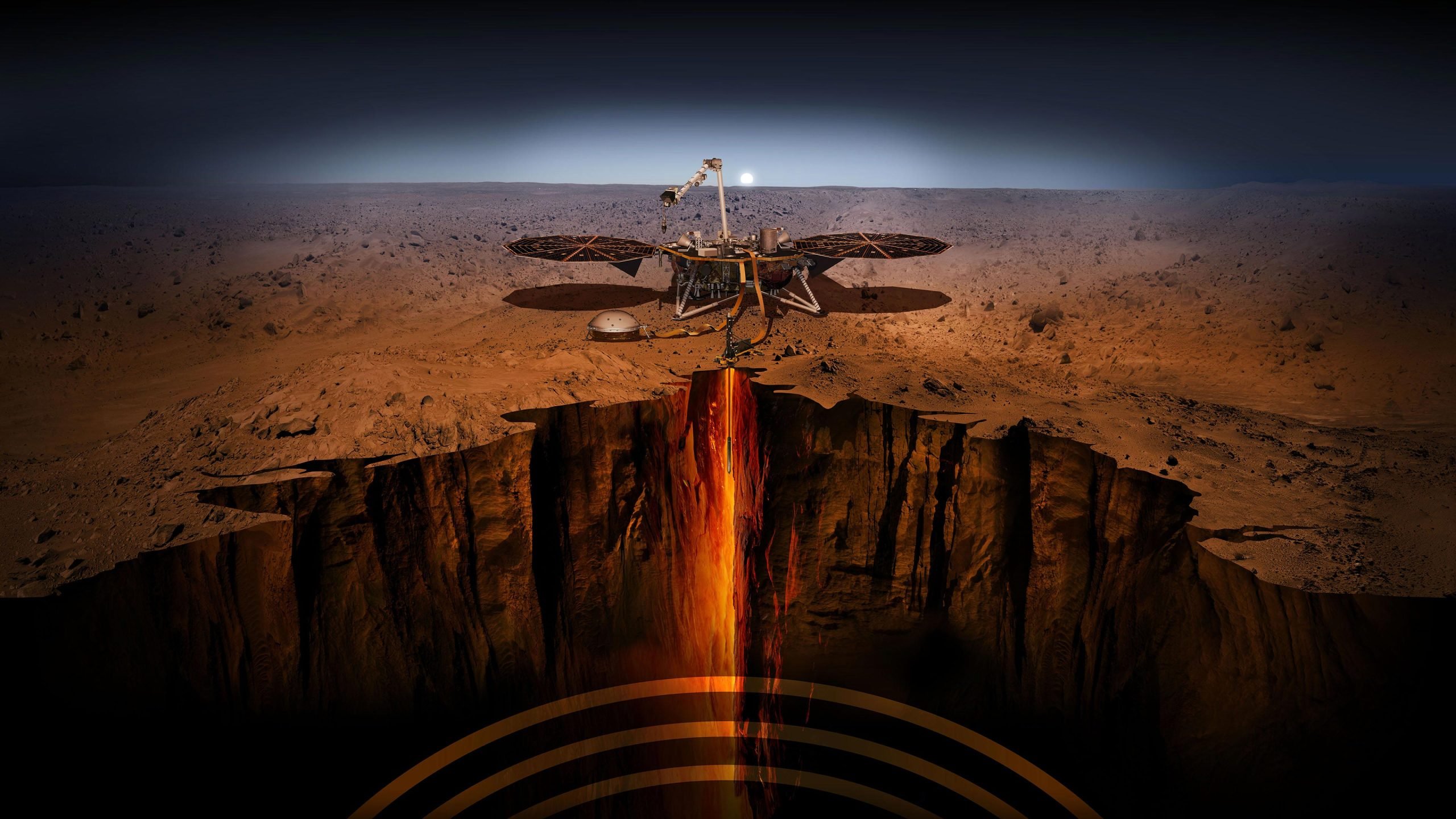

رسم توضيحي لفنان لمركبة إنسايت على سطح المريخ. تم تصميم InSight ، وهو اختصار للاستكشاف الداخلي باستخدام التحقيقات الزلزالية والجيوديسيا والنقل الحراري ، لمنح الكوكب الأحمر أول فحص شامل له منذ إنشائه قبل 4.5 مليار سنة. الائتمان: NASA / JPL-Caltech
تربط الفيزياء البيانات الزلزالية بخصائص الصخور والرواسب.
تحليل جديد للبيانات الزلزالية من مهمة المريخ إنسايت التابعة لناسا كشفت عن اثنين من المفاجآت الكبيرة.
المفاجأة الأولى: الجزء العلوي من 300 متر (1000 قدم) تحت السطح تحت موقع الهبوط بالقرب من خط الاستواء المريخي يحتوي على القليل من الجليد أو لا يحتوي على أي جليد.
“نجد ذلك[{” attribute=””>Mars’ crust is weak and porous. The sediments are not well-cemented. And there’s no ice or not much ice filling the pore spaces,” said geophysicist Vashan Wright of Scripps Institution of Oceanography at the University of California San Diego. Wright and three co-authors published their analysis on August 9, 2022, in the journal Geophysical Research Letters.
“These findings don’t preclude that there could be grains of ice or small balls of ice that are not cementing other minerals together,” said Wright. “The question is how likely is ice to be present in that form?”
The second surprise contradicts a leading theory about what happened to the water on Mars. It is believed the red planet may have harbored oceans of water early in its history. Many experts suspected that much of that water became part of the minerals that make up underground cement.
“If you put water in contact with rocks, you produce a brand-new set of minerals, like clay, so the water’s not a liquid. It’s part of the mineral structure,” said study co-author Michael Manga of the University of California Berkeley. “There is some cement, but the rocks are not full of cement.”

NASA’s InSight Mars lander acquired this image of the area in front of the lander using its lander-mounted, Instrument Context Camera (ICC) on April 11, 2022, Sol 1199 of the InSight mission. Credit: NASA/JPL-Caltech
Water may also go into minerals that do not act as cement. However, the uncemented subsurface removes one way to preserve a record of life or biological activity, Wright said. Cements by their very nature hold rocks and sediments together, protecting them from destructive erosion.
The lack of cemented sediments suggests a water scarcity in the 300 meters (1000 feet) below InSight’s landing site near the equator. The below-freezing average temperature at the Mars equator means that conditions would be cold enough to freeze water if it were there.
Many planetary scientists, including Manga, have long suspected that the Martian subsurface would be full of ice. Their suspicions have melted away. Still, big ice sheets and frozen ground ice remain at the Martian poles.
“As scientists, we’re now confronted with the best data, the best observations. And our models predicted that there should still be frozen ground at that latitude with aquifers underneath,” said Manga, professor and chair of Earth and planetary science at UC Berkeley.
In 2018, the InSight spacecraft landed on Elysium Planitia, a flat, smooth, plain near the Martian equator. Its instruments included a seismometer that measures vibrations caused by marsquakes and crashing meteorites.
Researchers can tie this information to a huge mass of knowledge about the surface, including images of Martian landforms and temperature data. The surface data indicated that the subsurface might consist of sedimentary rock and lava flows. However, the team still had to account for uncertainties about subsurface properties such as porosity and mineral content.
Seismic waves from marsquakes furnish clues to the nature of the materials they travel through. Possible cementing minerals—such as calcite, kaolinite, clay, and gypsum—affect seismic velocities. Wright’s team at Scripps Oceanography applied rock physics computer modeling to interpret the velocities derived from the InSight data.
“We ran our models 10,000 times each to get the uncertainties incorporated into our answers,” said co-author Richard Kilburn, a graduate student working in the Scripps Tectonorockphysics Lab led by Wright. Simulations showing a subsurface consisting mostly of uncemented material best fit the data.
Scientists want to probe the subsurface because if life exists on Mars, that is where it would be. There is no liquid water on the surface, and subsurface life would be protected from radiation. Following a sample-return mission, a NASA priority for the next decade is the Mars Life Explorer mission concept. The goal is to drill two meters (6 feet) into the Martian crust at high latitude to search for life where ice, rock, and the atmosphere come together.
Already under consideration is the proposed international robotic Mars Ice Mapper Mission to help NASA identify potential science goals for the first human missions to Mars. Scripps Oceanography helps prepare young scientists to contribute to such missions.
“All my life growing up, I’ve heard the Earth may become uninhabitable,” said study co-author Jhardel Dasent, another graduate student in the lab Wright leads. “I’m at the age now where I can contribute to producing the knowledge of another planet that may get us there.”
Reference: “A minimally cemented shallow crust beneath InSight” by Vashan Wright, Jhardel Dasent, Richard Kilburn and Michael Manga, 9 August 2022, Geophysical Research Letters.
DOI: 10.1029/2022GL099250
This research was funded by the National Science Foundation, NASA, and the CIFAR Earth 4D program.

“هواة الإنترنت المتواضعين بشكل يثير الغضب. مثيري الشغب فخور. عاشق الويب. رجل أعمال. محامي الموسيقى الحائز على جوائز.”
